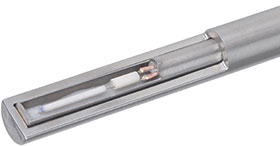

Within the process industry, two basic types of measuring resistors are used for electrical temperature measurement: wire-wound and film measuring resistors. Their different behaviour is reflected in the provisions of the European IEC 60751 (DIN EN 60751) standard, while the American ASTM E1137/E1137M treats the two types of resistors equally. This leads to confusion among users.
IEC 60751 leaves no room for interpretation. It lists the tolerance classes with their temperature ranges separately according to the nature of the measuring resistor. The basic values listed in the standard, the formulae for the permissible tolerance values and the test requirements apply to both types.
The detailed information has been present in the standard since 2008. The original EN 43760 standard from 1954 and its successors, from IEC 751 up to DIN EN 60751 from 1996, were developed on the basis of experience with wire-wound measuring resistors. Up to the revision of the standard, temperature ranges and class accuracies depended exclusively on the behaviour of wound platinum wires, which – embedded in ceramic or glass – change their resistance value as a function of the temperature.
The most important information, laid down as formulae and tables, was very clear. This included the basic values of -200 to 850°C, achieved using polynomials, and also two tolerance classes (A and B) and the associated temperature ranges -200 to 650°C (class A) and -200 to 850°C (class B).
Over the course of time, knowledge about the physical effects that occur in the platinum of the sensor at higher temperatures over longer periods of time has expanded. This has led to the necessity to adapt the standard to account for the drift behaviour of the measuring resistors so that it corresponds to the reality. A further reason for the revision was the development of film measuring resistors (also known as thin-film and flat measuring resistors or even chips for short) and their rapid market penetration.
This sensor type was not explicitly mentioned in the previous editions of IEC 60751: 2008 (DIN EN 60751: 2009). Users were therefore unsure whether the standard also applied to these new, cost-effective and exceptionally vibration-resistant measuring resistors. In particular, the specification of the temperature ranges suggested that film measuring resistors could be used at the same temperature limits and with the same accuracies as wire-wound measuring resistors. In reality, however, film measuring resistors behave differently to wire-wound measuring resistors, due to stretching and shrinkage effects as well as due to the diffusion of foreign atoms into the thin platinum layer. The result is a characteristic curve that leaves the standard range of permissible measuring deviations at low and high temperatures earlier than is the case with wire-wound measuring resistors. This behaviour physically arises as a result of the design and the materials used and must not be understood as a quality deficiency.
Readers wanting more information about updates to IEC 60751 and how the effects translate to the corresponding ASTM guidelines can download the full paper at http://instrumentation.co.za/+J1889
| Tel: | +27 11 621 0000 |
| Email: | sales.za@wika.com |
| www: | www.wika.co.za |
| Articles: | More information and articles about WIKA Instruments |
© Technews Publishing (Pty) Ltd | All Rights Reserved